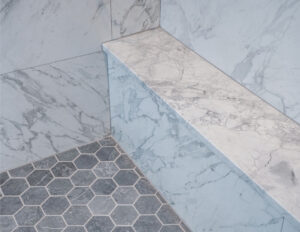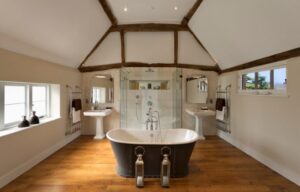Contents
- 1 Let’s Build a Home Gym You’ll Actually Use
- 2 Finding Your Fitness Footprint (Or, Where to Put All This Stuff)
- 3 The Foundation: It’s More Than Just Flooring
- 4 Choosing Your Arsenal: Equipment for Your Goals
- 5 Bringing Your Vision to Life: The Contractor Question
- 6 Your Home Gym Awaits
- 7 Frequently Asked Questions
Let’s Build a Home Gym You’ll Actually Use
We’ve all been there. You sign up for a gym membership with the best intentions, but then the thought of driving across town, finding parking, and waiting for the bench press just sucks all the motivation right out of you. What if the solution wasn’t a longer commute, but a shorter one? Like, walk-down-the-hall short.
Let’s talk about creating a home gym that fits your life, not the other way around. This isn’t about cramming a dusty treadmill in the corner of a spare room. We’re talking about designing a functional, motivating space you love. And sometimes, that means getting a little professional help to make it perfect. As the folks at Verified Builders here in Denver like to say, the best workout is the one you actually do, and having a dedicated, well-built space is half the battle.
Finding Your Fitness Footprint (Or, Where to Put All This Stuff)
The first step isn’t buying equipment; it’s figuring out where it will all live. You might be surprised by the potential hiding in plain sight.
The Usual Suspects: Spare Rooms & Basements
A spare bedroom is the classic choice. It’s already insulated, has power, and a door you can close. But let’s be honest, most of us don’t have a truly “spare” room. That’s where a smart basement renovation can come into play. A good basement remodel contractor can transform that under-utilized, sometimes damp space into the ultimate workout zone. Companies like Verified Builders specialize in this, ensuring your new gym has proper moisture control, ventilation, and flooring from the get-go.
Thinking Outside the Box: Garages & Patios
Don’t have a spare room or a basement? No problem. The garage is a fantastic, often-overlooked canvas. A garage conversion for a home gym is one of the most popular projects we see. It’s a separate space, often with high ceilings for those overhead presses, and you can make as much noise as you want. Similarly, if you’re in Colorado, a patio remodeling project with enclosed walls and climate control can give you a workout space with an incredible view. Just imagine doing yoga as the sun comes up over the mountains. Beats staring at a concrete wall, right?
When You Need to Create Space
Sometimes, the square footage just doesn’t exist in your current layout. This is where a home addition contractor becomes your best friend. Adding a dedicated room onto your home might sound like a big project (because it is), but it’s the ultimate way to get a custom-built space that meets your exact specifications. It’s the pinnacle of luxury home renovations for the fitness enthusiast.
The Foundation: It’s More Than Just Flooring
You wouldn’t build a house on a shaky foundation, and you shouldn’t build your gym on one either. This is where a lot of DIY attempts go wrong.
Why Your Floor Matters
Dropping a heavy kettlebell on concrete feels… bad. For you and the floor. You need a surface that absorbs impact, protects your equipment, and provides stability.
- Protection for Your Equipment (and Your House): Proper flooring prevents cracks in your foundation and concrete dust.
- Noise Reduction: Your family (and neighbors) will thank you. No one wants to hear the rhythmic thud of deadlifts at 5 AM.
- Safety and Comfort: A good floor provides traction and cushioning, reducing the risk of slips and joint strain.
We always recommend consulting with a general contractor on this. They can help you choose the right subfloor and top layer, whether it’s rubber tiles, rolls, or turf. It’s a key part of any serious bathroom remodeling or basement renovation project we tackle.
Here’s a quick breakdown of common options:
| Flooring Type | Best For | Pros | Cons |
|---|---|---|---|
| Interlocking Rubber Tiles | Most home gyms; heavy weights | Easy DIY install, durable, shock-absorbent | Can be pricey for high quality |
| Rubber Rolls | Seamless look; cardio areas | No seams to trap dirt, professional feel | Tricky to install perfectly |
| Foam Mats | Light yoga, bodyweight exercises | Inexpensive, soft | Not for heavy weights, can tear easily |
The Walls and The Ceiling
Think about the rest of the room, too. Mirrors are fantastic for checking your form, and they make a small space feel huge. Good lighting is non-negotiable – bright and energizing, not a single, sad bulb. And ventilation? Crucial. A remodeling company with experience in whole house remodeling will know how to integrate an extra vent or a quiet ceiling fan to keep the air fresh.
Choosing Your Arsenal: Equipment for Your Goals
This is the fun part. But before you max out your credit card, let’s be strategic.
The Non-Negotiables
Every gym needs a foundation. IMO, you should prioritize:
- A Quality Barbell and Bumper Plates: The cornerstone of strength training.
- A Power Rack or Squat Stands: Safety first. This lets you push your limits without a spotter.
- A Flat Bench: It’s not just for bench press.
- Adjustable Dumbbells: These space-saving marvels are a game-changer for home gyms.
Cardio: The Treadmill Dilemma
Be honest with yourself. Are you going to use that treadmill, or is it destined to become the world’s most expensive clothes hanger? If you love running, invest in a good one. If not, a simple jump rope and a commitment to outdoor runs might be better. A bathroom renovation contractor might not help you here, but they can ensure you have a great shower waiting for you post-workout.
Storage and Flow
How are you storing all this? A messy gym is an unmotivating gym. Wall-mounted racks for bars and plates keep things tidy and safe. Think about the “flow” of your workout. You shouldn’t have to trip over your dumbbells to get to your pull-up bar. This kind of thoughtful layout is what separates a pro remodeling company from a handyman. When you look for “home remodeling near me,” you’re looking for someone who thinks about how you’ll use the space.
Bringing Your Vision to Life: The Contractor Question
So, you’ve got the vision. Now, how do you make it a reality? This is where the rubber meets the road.
DIY vs. Pro: Knowing Your Limits
We get it, you’re handy. You can hang a TV and maybe even tile a backsplash. But when it comes to structural changes, electrical work for those heavy-duty outlets, or plumbing for a potential gym bathroom, calling a pro isn’t a cop-out; it’s smart. A home renovation contractor handles the permits, the inspections, and the headache. FYI, trying to DIY a basement renovation without proper knowledge of vapor barriers can lead to a very expensive, very moldy problem.
How to Find the Right Partner
You wouldn’t hire a trainer without checking their credentials, so why hire a contractor without doing your homework?
- Search Smart: Go beyond “basement contractors near me.” Look for “the nearest highly-rated bathroom renovation contractor” or “closest general contractor specializing in custom remodels.”
- Dig into Reviews: Read the reviews! What are past clients saying? Look for patterns, not just one-off comments.
- Verify and Interview: Any remodeling company worth its salt will be happy to show you their license and insurance. Then, have a conversation. Do they understand your vision? This is why we at Verified Builders always start with a deep-dive consultation. We want to understand not just what you’re building, but why you’re building it.
The Verified Builders Process
For instance, when you work with us at Verified Builders, your Denver home remodeling project starts with a clear plan. We talk about your budget, your timeline, and your fitness goals. We then handle everything from the initial design to the final clean-up, ensuring your new gym is built to last and perfectly suited to your lifestyle. It’s what makes us one of the top-rated house remodelers in the area. Why stress about coordinating electricians and floorers when you can have one team manage it all?
Your Home Gym Awaits
Creating your dream home gym is one of the best investments you can make in your health and your home. It removes excuses, saves you time, and gives you a personal sanctuary for self-improvement. Whether it’s a simple basement remodel or a full-scale home addition, the key is to plan carefully and build it right.
So, what are you waiting for? That perfect workout space isn’t going to build itself. Well, it can, but you need to make the call first 🙂
Frequently Asked Questions
How much does it cost to build a home gym?
This is like asking “how much does a car cost?” It depends massively on the scope. A simple DIY setup in a corner with some mats and dumbbells can be a few hundred dollars. A professional custom remodels project with high-end flooring, mirrors, built-in storage, and top-tier equipment can run into the tens of thousands. The biggest costs are usually the equipment and any construction needed to prepare the space.
What is the most important piece of equipment to start with?
For strength, we’d argue for a set of adjustable dumbbells and a solid bench. They’re incredibly versatile and space-efficient. For general fitness, a good yoga mat and your own bodyweight are all you really need to get started. Don’t fall into the trap of thinking you need everything at once.
Do I need a contractor for a home gym?
Not always. If you’re just laying down foam mats in a finished room, you’re probably fine. But the moment your project involves any of the following, you should seriously consider contacting a general contractor:
- Electrical work for dedicated circuits (for a sauna or heater).
- Any structural changes or wall removal.
- Finishing an unfinished space like a basement or garage.
- Installing permanent, heavy-duty flooring.
A good home renovation contractor ensures the job is done safely, to code, and will last for years.


